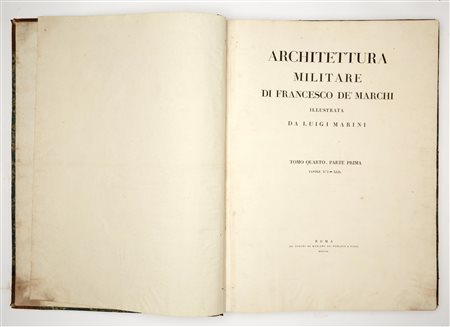 Itineris Casa d'Aste - Via Tiziano Vecellio 34/D, 10126 Torino
Itineris Casa d'Aste - Via Tiziano Vecellio 34/D, 10126 Torino
DIPINTI E SCULTURE ANTICHI E DEL XIX SECOLO - LIBRI ANTICHI - STAMPE E DISEGNI Prima Sessione - Libri antichi, disegni e stampe
Thursday 18 June 2020 hours 15:00 (UTC +01:00)
Francesco De Marchi (1504 - 1577) Architettura militare (...) illustrata da...
Francesco De Marchi (1504 - 1577)
Architettura militare (...) illustrata da Luigi Marini. Roma, da' torchi di Mariano de Romanis e figli, 1810.
2 volumi in-folio massimo, 778 x 540 mm. Mancano i primi 3 volumi di testo. I volumi in vendita sono gli ultimi 2 volumi della pubblicazione contenenti le tavole incise in rame con un formato disteso di 778x1080 mm. Nel tomo IV, tavole numerate I-XLIX, nel tomo V tavole numerate L-CIV. Sono tutte incise da Pietro Ruga e Giovanni Battista Cipriani, con date varianti dal 1805 al 1809.Legature in mezza pelle e vitello spugnato, con difetti e mancanze ai dorsi e ai piatti.Lotto non passibile di restituzione. Ad un anno dalla morte del De Marchi (1575) uscμ a Venezia dalla tipografia di Francesco Franceschi l'Architettura militare di Francesco Marchi capitano (tutti i commentatori concordano nel definirla senza data né luogo). Successive ristampe vennero eseguite per tutto il XVII e XVIII sec. circolanti anche sotto diversa paternità; a testimonianza di una crescente fortuna a fine Settecento, e per porre rimedio a una presunta carenza di copie, nel 1810 l'architetto L. Marini curò la presente ristampa del trattato, in cinque volumi in folio reale dal formato gigante, che furono naturalmente dedicati "alla Maestà di Napoleone I".
L'opera del De Marchi fu innovativa sotto diversi aspetti, ma probabilmente il piω importante si dimostrò il connubio tra fortificazione e tessuto urbano, studiato sui diversi tipi di territorio, monti, piano, marina, isola, perché per l'autore l'arte di fortificare "procede dalla natura", e deve quindi sfruttare le risorse orografiche del terreno, senza prevaricare l'aspetto estetico dell'insieme. Diede grande importanza allo studio dei materiali da costruzione ma soprattutto al disegno ed ai modelli in scala, da seguire scrupolosamente, per l'ottenimento del miglior risultato. 'L'importanza scientifica di questa opera, e delle aggiunte fattevi dal Marini, la splendidezza della edizione, la rendono rara, ricercata ed assai apprezzata dai bibliografi' (Riccardi). Per uno studio esaustivo dell'opera, si consulti Carlo Promis, in Misc. di storia italiana 4 (1863) 632-68. Cockle, 798 p.207; Fara, Il sistema e la città, 159-161; Riccardi, II, 111. (5)
Architettura militare (...) illustrata da Luigi Marini. Roma, da' torchi di Mariano de Romanis e figli, 1810.
2 volumes in grand folio, 778 x 540 mm. The first 3 volumes of text are missing. The volumes on sale are the last 2 volumes of the publication containing the engraved copper plates with an extended format of 778x1080 mm. In volume IV, numbered plates I-XLIX, in volume V numbered plates L-CIV. They are all engraved by Pietro Ruga and Giovanni Battista Cipriani, with dates varying from 1805 to 1809. Binding in half leather and sponged calfskin, with defects and shortcomings in the spines and boards. Lot not liable to be returned. One year after the death of De Marchi (1575), a Francesco Marchi 'Architettura Militare' was printed in Venice from the typography of Francesco Franceschi (all commentators agree in defining it without date or place). Subsequent reprints were made throughout the seventeenth and eighteenth centuries. also circulating under different authorship; testifying a growing fortune in the late eighteenth century, and to remedy an alleged shortage of copies, in 1810 the architect L. Marini edited the present reprint of the treatise, in five volumes in real folio with a giant format, which were naturally dedicated "to the Majesty of Napoleon I".
De Marchi's work was innovative in several respects, but probably the most important proved to be the combination of fortification and urban fabric, studied on the different types of territory, mountains, plain, marina, island, because for the author the art to fortify "proceeds from nature", and must therefore exploit the orographic resources of the land, without overriding the aesthetic aspect of the whole. He gave great importance to the study of building materials but above all to the design and scale models, to be followed scrupulously, to obtain the best result. "The scientific importance of this work, and the additions made by Marini, the splendor of the edition, make it rare, sought after and highly appreciated by bibliographers" (Riccardi). For an exhaustive study of the work, consult Carlo Promis, in Misc. Of Italian history 4 (1863) 632-68. Cockle, 798 p.207; Fara, The system and the city, 159-161; Riccardi, II, 111. (5)

























